#illinoisstatemuseum
Explore tagged Tumblr posts
Text
Discovering the Best of Springfield, Illinois: Fun Things to Do and See
Springfield is the capital of Illinois and is known for its rich history, vibrant downtown, and outdoor adventure opportunities. Whether you’re interested in exploring the city’s many historic sites and museums, biking on scenic trails, or enjoying the local cuisine and nightlife, there’s something for everyone in Springfield. Springfield, Illinois is the capital city of the Land of Lincoln and…
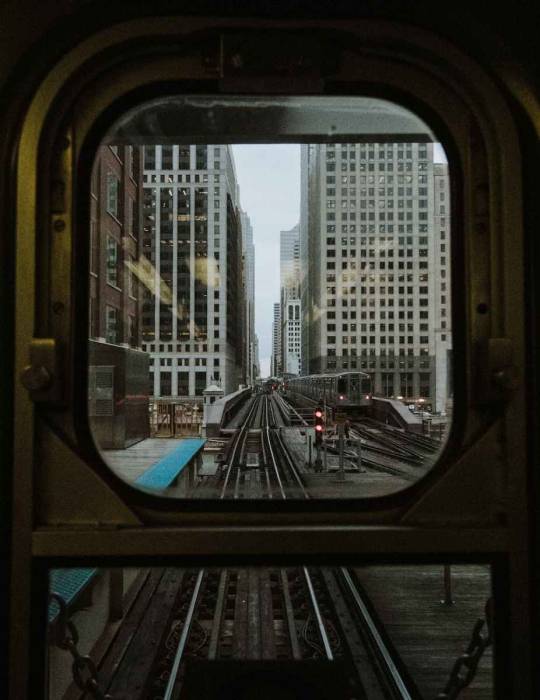
View On WordPress
#AbrahamLincoln#DowntownDistrict#history#IllinoisStateCapitol#IllinoisStateMuseum#LincolnHome#Midwest#OldStateCapitol#OutdoorAdventure#SangamonValleyTrail#SpringfieldIL#ThingsToDo#travel#WashingtonPark
0 notes
Text
Dedicated to the Birds
Museums are places of preservation and education, but also of on-going and important research. Curator can be defined as a keeper or custodian of a museum collection, but many curators are also researchers who work in the field as well as in the collection vaults.

H. David Bohlen curates the Ornithology collection at the Illinois State Museum and conducts long-term research on Illinois bird populations. In 1989, Dave authored “The Birds of Illinois,” a comprehensive survey of natural history information and museum records for 439 species of birds known at the time to occur (or previously occur) in Illinois.

Since 1970, Dave has monitored birds at locations all over Sangamon County, often going out in the field seven days a week and documenting many of his observations with photographs.

In 2013, he published the results of 40 years of study, reporting patterns of bird populations, including migration, breeding, arrival of new species in the area, and rare bird occurrences. Dave continues his field observations, now in his 48th year of study.

Long-term studies like this are invaluable sources of information about the natural world and how it has changed over time. They are a record of distribution and population trends that can be used to aid conservation efforts for species and the habitats they need to survive.


Photos by H Dave Bohlen: Black-bellied Whistling-Duck , Black-necked Stilt, Yellow-bellied Sapsucker, Yellow Warbler
3 notes
·
View notes
Text
Eleanor Spiess-Ferris: Daphne’s Sister
She’s a purveyor of vision, and leads us on a merry chase after, well, ourselves -James Yood, Eleanor Spiess-Ferris: An Appreciation, Sorrow of Swans, 2009
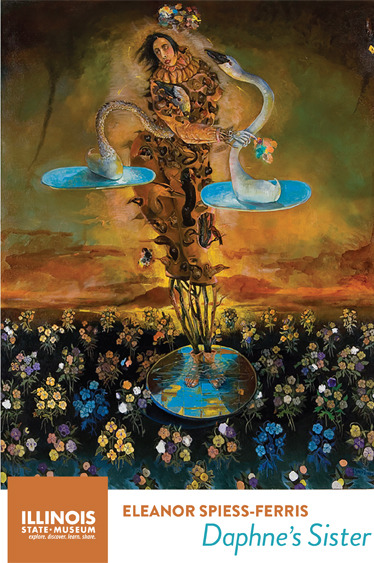
Eleanor Spiess-Ferris: Daphne’s Sister
Eleanor Spiess-Ferris (b. 1941, Las Vegas, NM. Resides, Chicago IL) is known for her distinctive approach to the figure, almost always women, who perform in dramatic settings. Her women are divas: larger than life, central to the story, and, like all good heroines, troubled by adversaries and circumstance.
Spiess-Ferris’s attention to the narrative body has deep art historical roots. Major influences are the visionary paintings of Hieronymus Bosch; Mannerist and Baroque arts attenuation of form and emotional atmosphere; Symbolist and Surrealist approaches to the fantastic, unreal situation and Feminist thought in the conflation of personal and political realities of women through history. Spiess-Ferris’s work is part of a strong tradition of figurative painting in the Midwest, which includes her contemporaries, Phyllis Bramson, Robert Lostutter, Tony Phillips, Christina Ramberg, and Suellen Rocca, along with modernist artists such as Gertrude Abercrombie, Ivan Albright, and Seymour Rosofsky.
In addition to her exploration of the figure, Spiess-Ferris also turns to the natural world for source material and inspiration. Her work is filled with birds, animals, flowers, trees, and water; constant companions and characters that help narrate the intertwined connection of humanity and nature. The questions of what animates and motivates us, as well as the consequence of our actions on the natural world, are central to her work.
This exhibition traces the development of Spiess-Ferris’s distinctive figures over 40 years of painting and drawing, often comparing studies and sketches with her final works. Spiess-Ferris has been drawing from a live model since the beginning of her career; an essential practice for her experimentation with the narrative figure. Her life studies often transform into their mythic selves in the process of a drawing session, shifting from observation into invention through distorting proportions and imposing natural forms as essential elements of the body.
Doug Stapleton, Associate Curator of Art, Illinois State Museum


(installation views: Eleanor Spiess-Ferris: Daphne’s Sister, Illinois State Museum, Springfield, IL, October 26, 2019 - February 16, 2020)
…[T]he shift we undergo from our world to her world, the immersion into some parallel universe when nature, animals, and humans all exist, just as we think we know them, but now functioning as integers in surprising and evocative narratives of mystery and wonder …’ —James Yood, Eleanor Spiess-Ferris: An Appreciation, Sorrow of Swans, 2009, exhibition catalog
The exhibition title Daphne’s Sister references the ancient Greek story of the nymph Daphne, who is transformed into a laurel tree to save her from the god Apollo’s unwanted advances. Spiess-Ferris never names Daphne in her work, but the suffering and endurance at the crux of Daphne’s story resonates through it. Spiess-Ferris’ figures are often depicted as hybrid creatures part human and part tree or bird, acknowledging shape-shifting as a strategy for survival. What is important in Daphne’s story is not that Apollo claims the laurel tree as his emblem, but that Daphne survives and thrives as a new species.
This painting, Fecundity, 2013, is a Daphne-like figure. She is a hardworking woman; balancing twin swan filled pools in a field of pansies while standing on delicate twig legs. She is between being and becoming, harboring life in her hands, but cautiously eyeing two approaching funnel clouds. If fecundity is a powerful productivity, then it is difficult, precarious work. The painting asks how we keep our balance, our sense of right and wrong, in relationship to all that we juggle.

Eleanor Spiess-Ferris, Fecundity, 2013, Oil on linen, Courtesy of the artist. ©Eleanor Spiess-Ferris

Eleanor Spiess-Ferris, Study for The Marauders, 1989, Graphite and colored pencil on sketchbook page, gift of the artist, 2018.41.59. ©Eleanor Spiess-Ferris
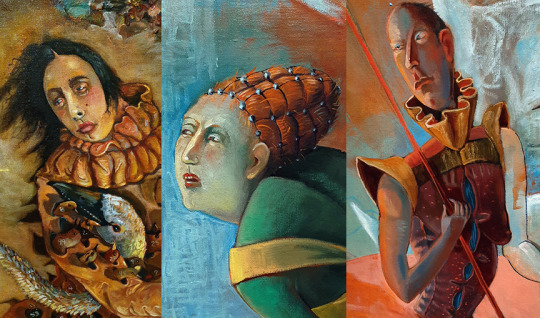
Figures are the essential storyteller in Eleanor Spiess-Ferris’s work. As such, the artist is more interested in how she can exaggerate her figures, bending, twisting and enlarging the forms to emphasize the emotional content of the work. Likewise, Spiess-Ferris is equally versed in rendering the figure with life-like realism. She has been involved for decades with the Evanston Figurative League, a group of artists who regularly draw from the figure as a means of honing their drawing and observational skills. Throughout the exhibition are examples of her drawings from the figure, which seem to stand in contrast to the exaggerated figures seen in the final paintings. Yet all of these images, from the quick contour sketch to the several hour-long poses from a model, speak to her understanding of how skin and bone, posture and gesture, can carry emotion and meaning. For her, imagination comes from observation, the original form elaborated and stretched into strange, new narrative figures.
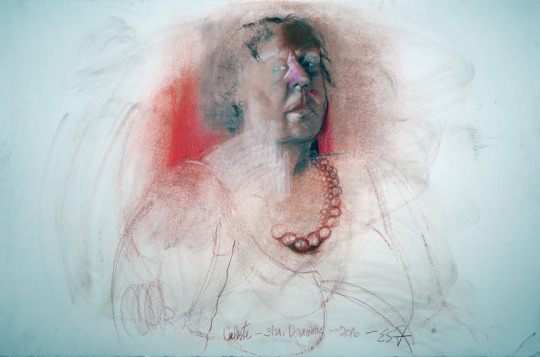
Eleanor Spiess Ferris, Untiled study (Celeste), 2016, Conte on paper, Courtesy of the artist. ©Eleanor Spiess-Ferris

Eleanor Spiess-Ferris, Lily, nd, Mixed media on paper, Courtesy of the artist. ©Eleanor Spiess-Ferris

Eleanor Spiess-Ferris, I Met a Rainbow in Argyle, 1976, Oil on canvas, Courtesy of the artist. ©Eleanor Spiess-Ferris
Spiess-Ferris’s paintings are allegories of the tides of fortune and consequence played out in often absurd situations. Her cast of characters includes clowns, ghosts, swan women, goddesses, suited skeletons, hobby horses, scarecrows, and crows. Spiess-Ferris’s figures are sometimes the main character, other times they are bystander or victim, pecked at by scavengers or poked and prodded by Picadillos—clownish demons. Who are her companions—these beasts and birds that accompany and sometimes inhabit the figure—and what is their part in the drama? They represent our interconnection, our intertwined fate with the natural world. They accompany the heroine on her many journeys; the birds are her voice; the demons are the embodiment of the consequence of our actions on a world turning uninhabitable.
These characters inhabit various worlds. In her early paintings from the 1980s and 1990s, you find them in stage-like settings with the curtains pulled back, revealing a tumbling operatic scene. In her later work, her figures move out into the world, floating in dark watery expanses or dwelling deep in the forest, more of residents now than actors passing through the scene.
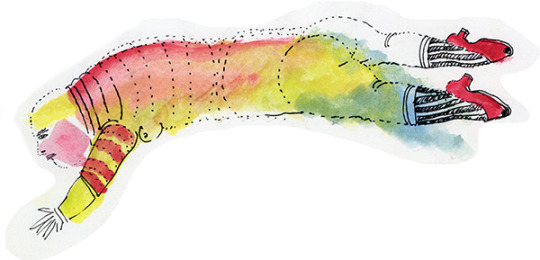
Spiess-Ferris’s earliest figures from the 1970s are rendered quickly, with a strong outline, minimal detail and broad strokes of color. These figures draw deeply on her childhood memories of northern New Mexico, especially the religious processions of the Spanish Penitentes and the ceremonies of the Pueblo Indians. In particular the sacred clown in Pueblo belief, a trickster who uses humor to make social commentary, has had a lasting impression on Spiess-Ferris’s figures. Northern Renaissance painter Hieronymus Bosch’s narratives scenes of Christian morality, heaven and hell as grotesque, carnival-like spectacle, also informs her work. These influences find bearing in her earliest paintings, such as the rainbow figure of I Met a Rainbow in Argyle and likewise in the drawing collage, Heaven, No Exit.
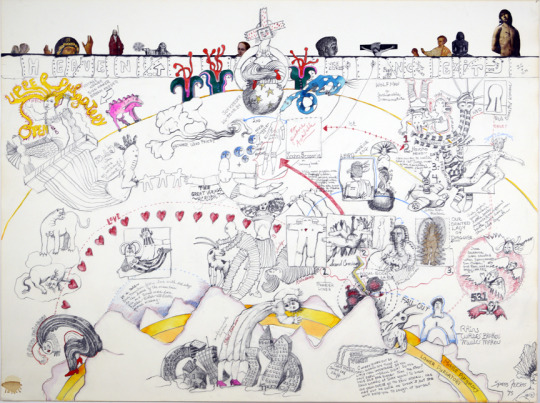
Eleanor Spiess-Ferris, Heaven No Exit, 1975, Graphite, color pencil, marker and collage on paper, Courtesy of the artist. ©Eleanor Spiess-Ferris

Eleanor Spiess-Ferris The Gray Room, 1980, Oil on canvas, Gift of the artist, 2009.26. ©Eleanor Spiess-Ferris
Spiess-Ferris's figures are rarely whole creatures. They are often depicted as fragments of a body or as hollowed skin or shell. The question of what animates us is central to her work. Is our outward appearance—how we present ourselves to the world—the true reflection of our inner life or just a costume we wear?
In Gray Room, 1980, Spiess-Ferris critiques the difficulty for women in finding their bearing and balance in a world where they are seen as sexual fantasies. The true person is not seen, only her ghost of a form, dressed up outlandishly. As a young artist finding her artistic voice, she used this ghost form repeatedly in her early work as an appraisal of female identity.
The idea of clothes animated to appear like human forms stem from Spiess-Ferris’s childhood memory of seeing clothes blown off a clothesline and caught up in tree branches. The clothes appeared to be alive as they billowed in the wind, as if the trees were dressing up to be recognized as human.

Eleanor Spiess-Ferris, Wild Sticks, 1982, Oil on Linen, Courtesy of the artist. ©Eleanor Spiess-Ferris
The memory of family from her New Mexican childhood inspire Spiess-Ferris’s Wild Stick figures, which are part of a series recollecting the daring exploits of her Aunt Maggie on horseback as well as her own memories of riding her palomino horse Snake. The memories—faded with the years and informed by pressing issues of adulthood—become ghost women riding hobby horses in a raucous race. Hobby horses symbolize a repeated activity—something we return to again and again—and these figures seem to be endlessly, urgently racing through time and space.
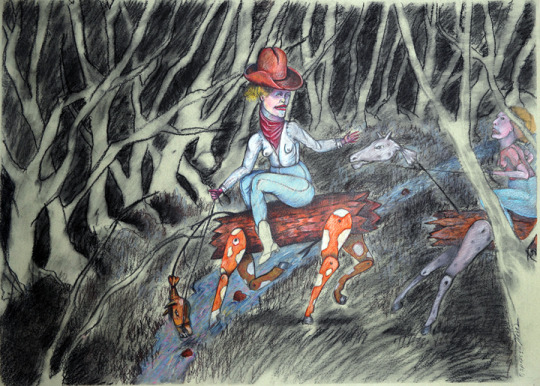
©Eleanor Spiess-Ferris
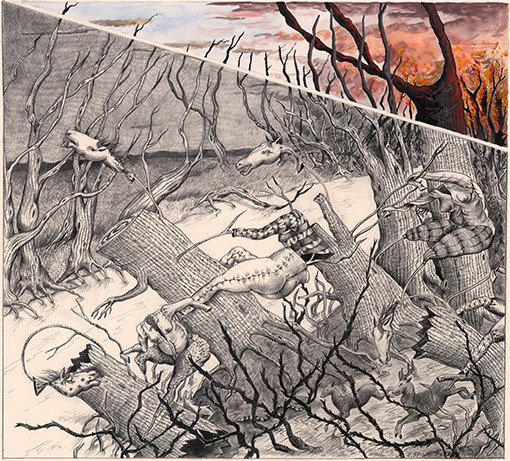
Eleanor Spiess-Ferris, Study for Wild Hunt, c. 1980s, graphite and gouache on paper, Gift of the artist. ©Eleanor Spiess-Ferris

Eleanor Spiess-Ferris, River, 2012, Oil on canvas, Courtesy of the artist. ©Eleanor Spiess-Ferris
Birds are a constant companion and inhabitant in Spiess-Ferris’s work; their chorus is its voice and breath. Birds inhabit the figure, nesting and finding protection in the limbs or the folds of the body. In River, 2012, they are an exposed nerve, a life force on a string held suspended above flowing time. James Yood wrote, ‘Birds are almost everywhere in her work as well, preening, pricking, nesting, cavorting, instinctive foils for the humans they abut, in their lust and vanity and hunger to survive becoming just like us.*’
* James Yood, Eleanor Spiess-Ferris: An Appreciation, Sorrow of Swans, 2009

Eleanor Spiess-Ferris, Tears, 2007, Oil on Canvas, Courtesy of the artist. ©Eleanor Spiess-Ferris
Eleanor Spiess-Ferris’s paintings balance absurdity and compassion. At first glance, we recognize their theatricality: outlandish costumes and hairstyles coupled with contortionist poses and dramatic lighting, which give the appearance of high comedy and satire. But the central storytelling brings us back to our own humanness and to the natural world, especially our relationship with water. There is a strong liaison with water—tears, sorrow, and regeneration—in Spiess-Ferris’s work, but rarely is this element single-purposed. In Tears, 2007, weeping women cry into vials that than pour out on the land, flooding the landscape. One woman offers small candle boats as an act of remembrance, while another carries her ancestors floating in her bowl-shaped head. In an interview, Spiess-Ferris explains,” Grief is not just totally bad—something comes out of it. … [S]he creates …by crying …she creates the environment in which the birds and things can exist through her grief. She’s an ecosystem. And she cries and will forever cry, but with her tears comes life.” *
*Gavin Van Horn, 2013, June 7, The Artist Who Would Be Crow, Center for Humans and Nature, www.humansandnature.org
Spiess-Ferris’s figures, armored and constricted in cloth as tight as skin, bristle in quilted or scaled discomfort. Bodies twist and double over or distort to resemble strange bug carapaces, as in A Small Sound, 2016. Deliberately distorted, these figures act as a visceral reminder of how we feel emotions in our bodies. There is something powerful in the contorted figures, which, like clowns and jesters, use absurdity to drive home a pinprick of recognition of ourselves.

A Small Sound, 2016, Gouache on paper, Courtesy of Audrey Niffenegger. ©Eleanor Spiess-Ferris

Eleanor Spiess-Ferris, The Chair, 2010, Gouache on paper, Courtesy of the artist. ©Eleanor Spiess-Ferris

Eleanor Spiess-Ferris A Mama’s Tears (study for The Chair, 2011), n.d. (c.2011), graphite on paper, Gift of the artist. ©Eleanor Spiess-Ferris

Eleanor Spiess-Ferris, Islands, 2004, Oil on Linen, Courtesy of the artist. ©Eleanor Spiess-Ferris
In Islands, 2002, garland-wreathed heads float as a silent procession in a sunken, twilight world, each person calmly surveying the darkness by the light of a powerful spirit lamp. Are these heads the islands of this title, or is the island our collective humanity afloat in a larger world full of unknowns? Some figures sport elaborate collars or wreaths of flowers around their neck, while another wears a wooden dunce hat full of birds. In the middle, one man balances a single white lily stalk, symbolizing the Virgin Mary—the compositional centerpiece of this procession of hope and mercy. ‘The theme of caretaking strongly transmits,’ writes nature and ethics scholar Gavin Van Horn. ‘There is a guarded optimism in the organic intertwining of human and nonhuman life, in which heads become lifeboats, thoughts become branches filled with song and chatter, and bodies are pierced and re-aggregated into something greater than their parts.*’
*Gavin Van Horn, 2013, June 7, The Artist Who Would Be Crow, Center for Humans and Nature, www.humansandnature.org

Eleanor Spiess-Ferris, Inflated Ego, 2008, Oil on Canvas, Courtesy of the artist. ©Eleanor Spiess-Ferris
I wish there were better words to describe the emotional tenor of a work by Spiess-Ferris, melancholic, brooding, wistful, heartfelt, poignant, tragic, tender, etc., none fully does the trick, but in some combination, help to gauge the psychological temperature that she regularly achieves. The complex Inflated, Egos, 2008, is so diverse and rich, it takes us to a place of dreams and nightmares, fireballs cascading from the orange and apocalyptic sky while, in a sliver of blue water, a few of Spiess-Ferris’s signature actors and actresses float about on or among some very expressive swans. There’s a hothouse and claustrophobic feeling here, we see broad areas of suggestive emptiness juxtaposed with an intense but ambiguous narrative episode. Why are these curiously costumed individuals sailing about, … sporting inefficient and symbolic umbrellas and the like… what is their relationship to one another, are they vulnerable or somehow self-contained? More questions than answers, as is often true in this artist’s work—but images such as this provide that aperture to wonder and imagination that invite us to speculate and fantasize, to question and, finally, to surrender.
James Yood, Eleanor Spiess-Ferris: An Appreciation, Sorrow of Swans, 2009

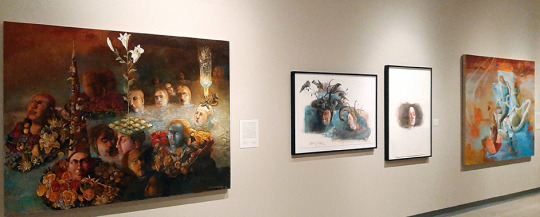
(installation views: Eleanor Spiess-Ferris: Daphne’s Sister, Illinois State Museum, Springfield, IL, October 26, 2019 - February 16, 2020)
Additional images

Eleanor Spiess-Ferris, Autumn, 2002, Oil on linen, Courtesy of the artist. ©Eleanor Spiess-Ferris

Eleanor Spiess-Ferris, Untitled Figure study, Nd., Conte on paper, Courtesy of the artist. ©Eleanor Spiess-Ferris

Eleanor Spiess-Ferris, Gathering Swans, 2002, Oil on canvas, Courtesy of the artist. ©Eleanor Spiess-Ferris
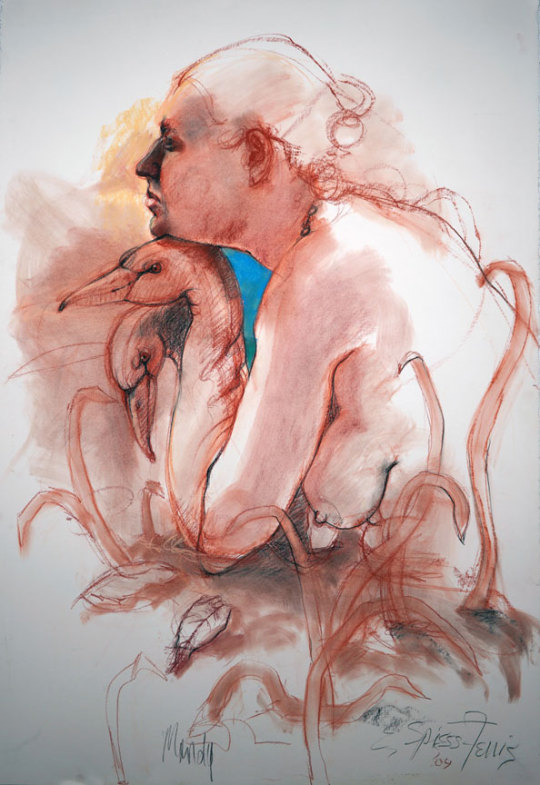
Eleanor Spiess-Ferris, Untitled study (Mandy), 2004, Conte on paper, Courtesy of the artist. ©Eleanor Spiess-Ferris

©Eleanor Spiess-Ferris

Eleanor Spiess-Ferris, Those That Were Left Behind, 2002, Oil on canvas, Courtesy of the artist. ©Eleanor Spiess-Ferris
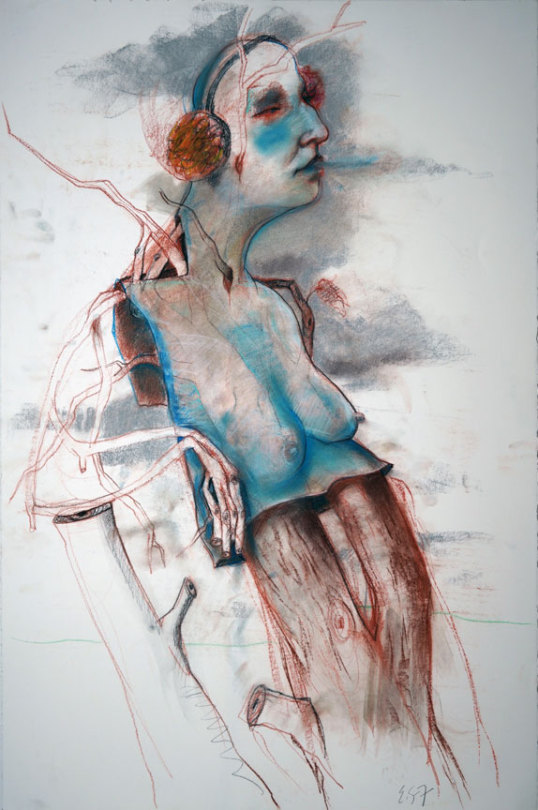
Eleanor Spiess-Ferris, Untitled study (related to Those That Were Left Behind, 2002), Nd, Conte on paper, Courtesy of the artist. ©Eleanor Spiess-Ferris
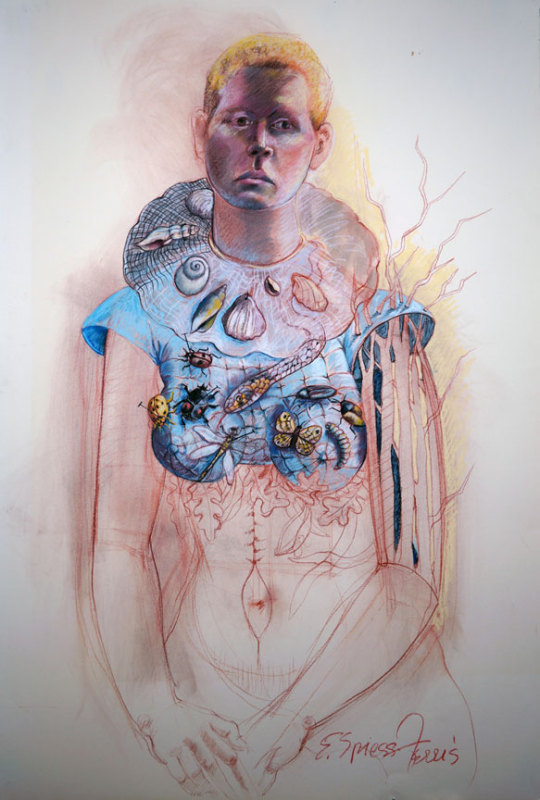
Eleanor Spiess-Ferris, Untitled (related to figure in The Basket, 1993), 1990s, Conte on paper, 30 ¼ x 44”, Courtesy of the artist. ©Eleanor Spiess-Ferris
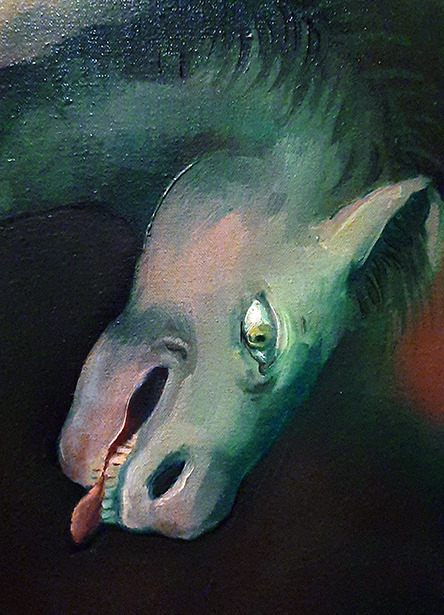
©Eleanor Spiess-Ferris
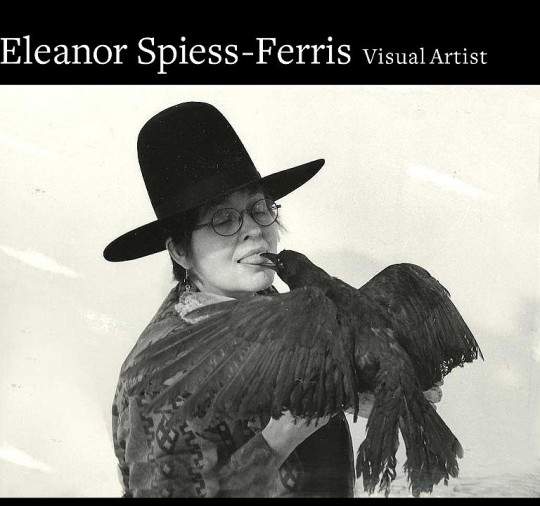
Eleanor Spiess-Ferris: Daphne’s Sister was presented at the Illinois State Museum, Springfield, IL, October 2019 - Feburary 2020, and at the Evanston Art Center, Evanston, IL, March 2020.
0 notes
Photo

Come out and see the two new exhibits at the #IllinoisStateMuseum. Pictured above is from the Fine Art exhibit, Stillness, curated by Doug Stapleton. It features impressive #stilllife art work from a number of #artists. . #illinoisart #springfieldil http://ift.tt/2FQnORk
1 note
·
View note
Photo

Picked this drawing up from the framers today and will be submitting it to the Illinois State Museum Plein Air 17 show. Lock 1, Lockport, Illinois. Ink on watercolor paper. Inquire for pricing. #andrewbanksillustration #ink #drawing #lockportillinois #drawing #pointillism #illustration #iblackwork #dotwork #inkdrawing #inktober #inktober2017 #framing #customframing #illinoisstatemuseum #pleinair #plainair17 #fountainpen #dudekmoderngoods #twsbi #noodlersink #archisketcher #arch_more #arqsketch #art #chicagoart http://ift.tt/2hPvasW
2 notes
·
View notes
Photo

Thank you to the #vroomanmansion for hosting us for our "on location" photo shoot of our 1890s dress. You'll see the photo in the catalog for "Fashioning Illinois, 1820-1900", opening next spring. #IllinoisStateMuseum #FashioningIllinois https://ift.tt/2MsthEc
0 notes
Photo

Abe up top. #totem #illinoisstatemuseum #history #100thingstodoinspringfieldbeforeyoudie #secondeditioncomingsoon #localauthors #reedypress #writersofinstagram #springfieldillinois https://ift.tt/2V9bToU
0 notes
Photo

Figurism: Narrative and Fantastic Figurative Art from the Illinois State Museum Collection.
presented at the Schingoethe Center of Aurora University, 347 S. Gladstone Ave., Aurora IL 60506-4892
Exhibition dates: February 11 - April 24, 2020
opening reception: Tuesday, February 11, 5-6:30 pm.
visit: auartsandideas.com or call 630-844-4924
FIGURISM brings together modern and contemporary artwork from the Illinois State Museum collection that emphasizes the power and range of the narrative and expressive figure in Midwestern art. Featured artists include Gertrude Abercrombie, Ivan Albright, Phyllis Bramson, Eldzier Corter, Riva Lehrer, Gladys Nilsson, Ed Paschke, Tony Phillips, Judy Raphael, Barbara Rossi, Elenaor Spiess-Ferris, and Karl Wirsum.
0 notes
Photo

Thank you to the #vroomanmansion for hosting us for our "on location" photo shoot of our 1890s dress. You'll see the photo in the catalog for "Fashioning Illinois, 1820-1900", opening next spring. #IllinoisStateMuseum #FashioningIllinois https://ift.tt/2MsthEc
0 notes
Photo

This German language "Heilige Schrift" (holy scripture) book from the 1880s was more than just a book on religious instruction. Its teachings also included text and detailed illustrations on various educational subjects including history and zoology. #NationalBookLoversDay #IllinoisStateMuseum #AntiqueBooks #IllinoisLegacyCollection https://ift.tt/2YUCon1
0 notes
Photo

This German language "Heilige Schrift" (holy scripture) book from the 1880s was more than just a book on religious instruction. Its teachings also included text and detailed illustrations on various educational subjects including history and zoology. #NationalBookLoversDay #IllinoisStateMuseum #AntiqueBooks #IllinoisLegacyCollection https://ift.tt/2YUCon1
0 notes
Photo

Get your game on today at the Museum for Super Saturday, 11-3pm! #illinoisstatemuseum http://bit.ly/2XjTYwz
0 notes
Photo

Get your game on today at the Museum for Super Saturday, 11-3pm! #illinoisstatemuseum http://bit.ly/2XjTYwz
0 notes
Photo

Another important aspect of the Illinois State Museum library is maintaining the archives. It contains all the important papers and documents that have been generated by previous Museum directors and staff, records of Museum programs and exhibits, and other collections that help tell the story of the ISM's incredible 142 year history. #NationalLibraryWeek #IllinoisStateMuseum #storyofISM http://bit.ly/2uYwctv
0 notes
Photo
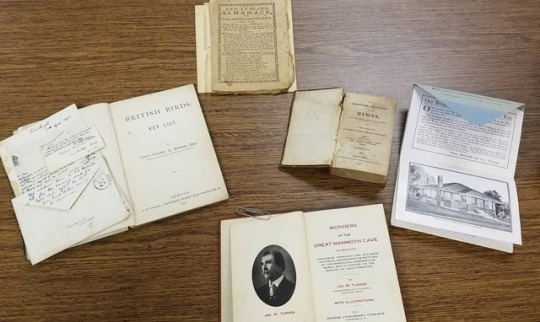
One of the exciting things about having a museum library is the occasional donation of rare books! The Illinois State Museum library has quite a rare book collection, most of them dating from the late 1800s to the early 1900s, but from time to time, we receive a donation that goes back much further. 📚 The items pictured here range from 1918 all the way back to 1770, and one of the books even came with an old calling card and some correspondence from a prominent ornithologist. 📚 #NationalLibraryWeek #RareBooks #LibraryCollection #IllinoisStateMuseum http://bit.ly/2D4VtGM
0 notes
Photo

Happy National Library Week! Not only does the ISM Library have over 30,000 cataloged books in its collection – it also curates a number of special collections that don’t fit other areas of the Museum. 📚 The items pictured here are part of the library’s ephemera collection, containing interesting odds and ends such as items in the Route 66 vertical file, collectible needle books, cigarette silks, quilt show ribbons, newspaper articles, and scrapbooks. 📚 #NationalLibraryWeek #Route66 #quilting #LibraryCollection #IllinoisStateMuseum http://bit.ly/2FY7WNp
0 notes